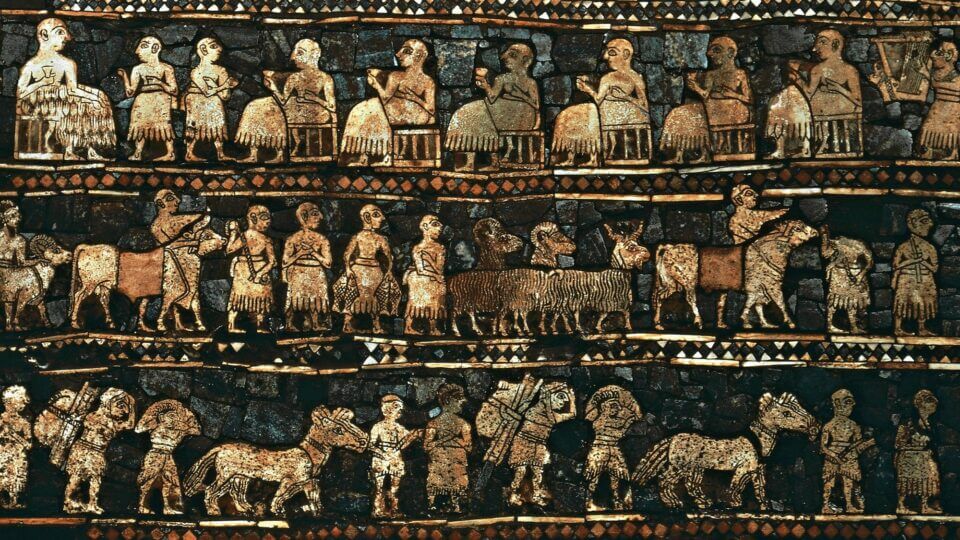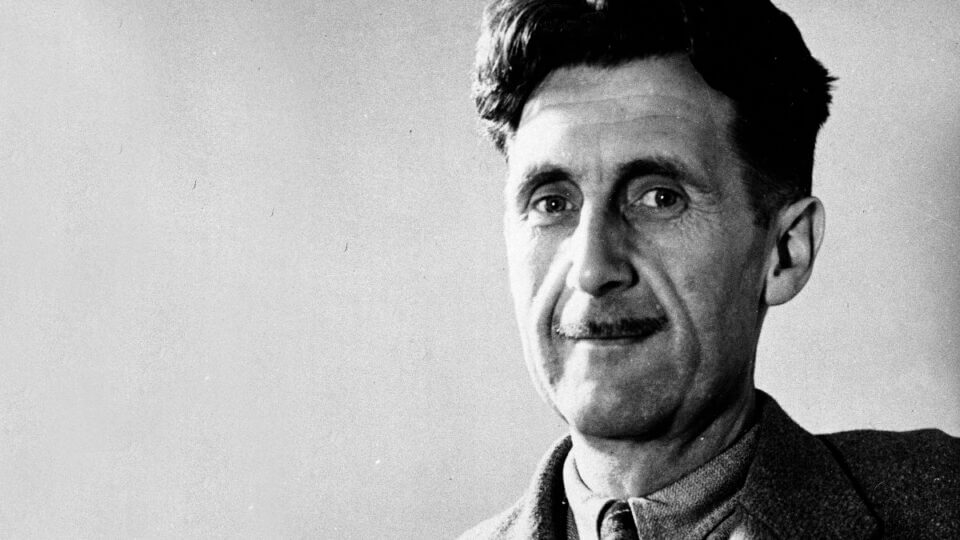
“While seemingly contrary in ‘theory,’ the great totalitarian systems—fascism and communism—would have a great deal in common in practice. Both are manifestations of the human Ego flailing about in a world reduced to Nothing.”
“I shall take up dominoes again in my spare time.”
—Czar Nicholas II in March, 1917
In 1916, several young men and women from a variety of European countries made their way over the mountains into neutral Switzerland. They were mostly artists and poets, alienated by what they perceived as the madness of war and the cultural collapse of Europe. They refused to fight, wrote German poet Richard Huelsenbeck, for “…the idea of a nation which at best is a cartel of pelt merchants…at worst, a cultural association of psychopaths.”
The refugees would regularly congregate at a café in Zurich called Cabaret Voltaire. They discussed art and politics and staged satirical skits on current affairs. They called themselves “Dadaists.” The nonsense word “dada” was emblematic of an artistic movement that reflected the times. Exactly what “dada” stood for was unclear—a nonsense word for nonsensical times.
What Dadaists had in common was an experience of annihilation, chaos, meaninglessness, and a general disgust with (and resentment of) the dominant bourgeois morality. “DADA is the voluntary destruction of the bourgeois world of ideas,” said one slogan; otherwise, wrote Huelsenbeck, they “actually had no idea what they really wanted.” They were not even sure as to what art was any more or what it should be or could be. “Art just was. There were artists and there were bourgeois. You had to love one and hate the other.”
The Dada movement quickly spread throughout Europe resonating with a widespread sense of alienation and chaos. Dada represented a response to a civilization in the process of its own annihilation. The fragmented consciousness of Dadaists reflected the greater social and physical fragmentation of Europe. Dada, in effect, reflected the historical force of Nothing. “Everybody knows Dada is Nothing,” wrote Tristan Tzara in 1924. Dada is about negation and, as I have argued, Nothing as a negating force had been sweeping through Europe toppling one institution after another, one convention after another, finally culminating in a worldwide conflagration. Much of Europe and the world was ground down by Nothing into Nothing.
Chaos may reflect war and destruction; however, if affirmed and transformed, chaos is also an opportunity for growth and renewal.
Very much as Nietzsche had prophesied, Europe found itself in a state of social and psychological chaos. For Nietzsche, chaos represented an unprecedented disaster but also unprecedented opportunity. Only by embracing the forces of its collapse could Europe reinvigorate itself. Nietzsche warned in Thus Spake Zarathustra of the emergence of a particularly debased kind of human being that he called “the last man.” The last man, as “ineradicable as the flea beetle,” was smug, shallow, and, above all, incapable of creative transformation. Near the beginning of his prophecy of the last man Nietzsche wrote:
“’I say unto you: one must still have chaos in oneself to give birth to a dancing star. I say unto you: you still have chaos in yourselves.’”
The word “chaos” is from the Greek, suggesting disorder or formlessness. What Nietzsche understood is that existence itself is a dynamic of disorder and order or, as the Greeks would say, chaos and cosmos. Chaos may reflect war and destruction; however, if affirmed and transformed, chaos is also an opportunity for growth and renewal. Chaos in itself is meaningless. But how we respond to chaos is what generates meaning, art, and civilization itself. We give birth to “dancing stars” by embracing and transforming chaos.
Nietzsche feared that if we were not inspired by chaos, we would become stupefied by chaos. In a famous aphorism in Beyond Good and Evil, he wrote:
“He who fights monsters should look to it that he himself does not become a monster. And when you gaze long into an abyss the abyss gazes into you.”
Nietzsche, as a trained philologist, no doubt knew that the etymology of “abyss” is related to both the Greek and Latin for “gaping void,” “primeval chaos.” An over-fixation on chaos, fragmentation, and Nothing could only result in a chaotic, fragmented, and nihilistic mind. Beware fixating on Nothing; Nothing fixates on you.
Artists, those emblematic of our human powers of creativity, were gazing into Nothing. A few would retain their clarity and integrity (Kandinsky, Klee, etc.), and, in their own way, they would embrace and transform chaos. Many others, though, would succumb to the powers of Nothing and dream dreams of liberation. Many would imagine they could make a new reality ex nihilo. Even, or especially, Dadaists issued manifestos, dreamed of utopias, and celebrated disruption and violence.
In a state of extreme social and psychological fragmentation, human ideas cease to establish a relationship to outer reality. The human mind flails about, frightened, resentful, grabbing at whatever is at hand. This particular time of chaos turned out not to be a time of creativity and transformation. Quite the contrary, it was a time of ideological frenzy and brute force. When “things fall apart,” wrote Yeats in his prophetic 1919 poem “The Second Coming,” “the best lack all conviction while the worst/Are full of passionate intensity.” The worst were not motivated by love and a capacity to transform chaos into some meaningful whole. The worst would turn out to be those most enchanted by Nothing, those most possessed by Nothing. And, as Nietzsche feared of such monsters, they would not simply be cruel and stupid. These “rough beasts” would apotheosize their own resentment and drag the world deeper into the abyss.
To Dachau
In his 1907 novel The Secret Agent, Joseph Conrad depicts a conversation between his Professor and a fellow revolutionary in which they discuss possible societies arising out of a world reduced to Nothing. Decades before the actual emergence of totalitarian rule, Conrad understood that new kinds of rule might take two possible forms. In one form, society might resemble “an immense and nice hospital with gardens and flowers, in which the strong are to devote themselves to the nursing of the weak.” The Professor is appalled by this vision of society and posits a contrary vision. “The weak,” insists the Professor “are the source of all evil. They are our sinister masters—the weak, the flabby, the silly, the cowardly, the faint of heart, and the slavish of mind. They have power, theirs is the kingdom of the earth. Exterminate, exterminate. That is the only way of progress.”
For millennia, societies always have consisted of a mutually beneficial relationship between a few “strong” and a larger number of the “weak.” In a world reduced to Nothing, this dynamic now appears as an irreconcilable conflict. And, indeed, the two great emergent totalitarian systems would reflect this new reality. The totalitarian Left would champion the dispossessed and look to free itself from millennia of exploitation from greedy and capricious masters. On the other hand, the totalitarian Right would exalt the strong and struggle to rid the world of the pestilential weak.
While seemingly contrary in “theory,” the great totalitarian systems—fascism and communism—would have a great deal in common in practice. Both are manifestations of the human Ego flailing about in a world reduced to Nothing. Both arise from a state of social and psychological fragmentation: what Hannah Arendt calls “atomization.” Both involve a break with history and tradition: They reject liberal Enlightenment ideals of free markets and representative democracy. Both loathe the bourgeoisie. Both fascism and communism disregard actual reality and are guided by the pursuit of some utopian abstraction.
Totalitarian visions are revenge fantasies animated by a desire to destroy what is in order to be replaced by what should be.
Totalitarian societies are nihilistic societies; they do not recognize themselves as participants in a universe of greater powers. It has been said that Karl Marx substituted the worship of God with the worship of History. This is misleading. For Marx, history has a teleological function; it dissolves one economic relationship after another as it rushes inexorably to the complete dissolution of oppressive economic relationships and the liberation of the individual. The logic of history dissolves history; the logic of history is a manifestation of the emancipating powers of Nothing. The achieved state of “communism” is a state of individual liberation. Marx is ultimately not so concerned with economics or ideology as he is with liberation. Marxism is a secular Christian apocalyptic myth. Marx, too, is under the spell of Nothing and Ego.
German fascism presumes to appeal to nature and justify itself as engaged in an elemental Darwinian struggle for life. However, it would manifest no interest in adapting itself to the paradoxical forces of nature. Fascism is essentially an atavistic fantasy that posits some idealized state of racial purity that can only be realized by purging the world of the impure. Prefiguring the coming fascism, Conrad’s Professor articulates this need for purification: “Every taint, every vice, every prejudice, every convention must meet its doom.” The Professor’s fellow revolutionary then asks, “And what remains?” The “sallow little Professor” simply answers: “I remain—if I am strong enough.” Here too we see in fascism the forces of annihilation in the service of a kind of liberation.
While essentially nihilistic, no modern totalitarian society, in practice, would remotely resemble Stirner’s happy “union of egoists.” In totalitarian societies, the individual Ego is crushed and absorbed into the collective, into what Rousseau called “the general will.” The general will, in turn, is perfectly embodied in the “leader”—“der Fuhrer,” “il Duce,” “the Chairman,” etc. All individual Egos are, in effect, devoured by one wholly dominant Monster Ego. Theoretically, the Monster Ego is guided by the “ideal,” but, as perceived by his followers, the Monster Ego is always infallible. Only the Monster Ego can presume to say with Max Stirner, “I am all and nothing.”
Totalitarian visions are revenge fantasies animated by a desire to destroy what is in order to be replaced by what should be. Totalitarian societies are Frankenstein societies, cobbled together from the rubble of history and animated by those possessed by Nothing. They tend to become orgies of resentment, perpetual sacrifices to the Moloch of theoretical purity. Sometimes, the strong are to be annihilated for the benefit of the weak; sometimes the weak are to be annihilated for the benefit of the strong. Those who have no place in the future Utopia are “objective enemies”: the weak, the lame, Jews, kulaks, capitalists, etc. They are not, ultimately, to be simply ghettoized or persecuted or even killed. They are to be exterminated, annihilated, rendered to Nothing—or, as we might say today, canceled.
Fashioned in iron across the top of the gates of Dachau Prison are these words: “Arbeit Macht Frei” (“Work Makes Free”). What must possess a mind to conceive of annihilation as a means to liberation? It is perhaps not a coincidence that the very word “utopia” means “no place.” Utopias are nowhere worlds for people possessed by Nothing ideas. So what great generic motto might we hang over the gates of all of these nowhere societies? How about “Everything deserves to perish”?
To Davos
The great totalitarian experiments would collapse or crumble from their own absurdity—but not before bringing the world to its knees. Horrified and chastened by our exposure to “the extreme,” we set about reconstructing the world out of the rubble. In doing so, we would turn to the much-maligned bourgeoisie for help.
The bourgeoisie may be shallow and self-serving, but they are extremely proficient at generating wealth. Again, in the latter part of the 20th century, we see the reassertion of Enlightenment ideals: free markets, democracy, and faith in social and technological progress. The frightening powers of the strong could be sublimated into the pursuit of wealth which, in turn, could be leveraged for the benefit of all. The strong and the weak again reach a kind of identity of interests. What we see in the so-called “free world” of the latter half of the 20th century is Right and Left ideologies in a kind of tempered accommodation; one generates wealth, while the other cleans up the disruptions and spreads the wealth around somewhat. This political arrangement appears so successful that Francis Fukuyama would famously proclaim “the end of history.”
Almost exactly a century later, we were in our second Belle Époque. Democracy and capitalism seemed to be spreading around the globe, while authoritarian societies (both traditional and modern) appeared to be in decline. Drawing on Hegel and his great interpreter, Alexandre Kojève, Fukuyama argues that the logic of history ends with democratic liberal capitalism. We have achieved a kind of rational balance of the weak and the strong. The world, argues Fukuyama, could be built upon “the twin pillars of rational desire and rational recognition.” It appears that “liberal democracy constitutes the best possible solution to the human problem.” And while we may be back to Stirner’s “curse of halfness” and “spiderwebs of hypocrisy,” there are no more ovens, no more gulags. No more Dachaus but a lot more Davos.
Human reason alone cannot know the essential or “true” nature of reality. We can only know paradoxical reality by analogy, by myth.
The full title of Fukuyama’s 1992 highly influential book is The End of History and the Last Man. Very much as Nietzsche prophesized, the last man follows from the Death of God which, itself, would apparently precipitate the end of history. The last man supersedes the bourgeoisie as a human type. He accepts the materialist world but is more “educated,” cultured, and socially conscious than the boorish bourgeoisie. The secular last man believes he has transcended “the formerly mad” world of history and that a just civilization can be generated from good intentions and the beneficent rule of experts. The last man is essentially a bourgeoisie with a social conscience.
Fukuyama is an Enlightenment thinker, and he manifests the virtues of Enlightenment philosophers. He is observant, reasonable, and judicious. Fukuyama wrote The End of History at a time of relative stability and prosperity in the world. The Soviet Union had just collapsed, new technologies were proliferating, and free trade was spreading wealth around the world. Even China appeared to be getting on board. Guided by reason, Fukuyama could identify certain patterns and trends; indeed, history itself, as Hegel argued, appeared rational.
Fukuyama acknowledges possible liabilities at the end of history. He recognizes the shallowness of the last man but accepts this as a necessary trade-off to maintain harmony, a way of sublimating our human desire for dominance. While Fukuyama acknowledges the possible return of the domineering few, he also acknowledges the possible emergence of a destabilizing “relativism.” “Modern thought,” he writes, “raises no barriers to a future nihilistic war against liberal democracy by those brought up in its bosom.” Fukuyama’s hope is that human reason can (and will) recognize the futility to this kind of challenge.
While manifesting the virtues of Enlightenment thinkers, Fukuyama also suffers their vices. Human reason is certainly capable of recognizing order and patterns, but this does not mean that reality can be controlled by reason—let alone made over by reason. Perhaps the greatest conceit of modern man is an inordinate faith in the power of human ideas to remake reality. Fukuyama talks as if reason can freeze history in its currently reasonable manifestation. Fukuyama argues that the end of history is a result of rational processes which he hopes can be maintained by rational processes.
Nietzsche claims philosophy begins where reason ends. To philosophize truly requires recognizing forces or powers beyond reason and beyond full human comprehension. What we actually experience are the paradoxical and unified forces of order and disorder. Human reason alone cannot know the essential or “true” nature of reality. We can only know paradoxical reality by analogy, by myth. We live by some series of poetic interpretations, by a “mobile army of metaphors.” We live by generating meaning, and no amount of reason or science can generate meaning. We either willingly participate in reality or not; there is no escape from the whole. Fukuyama claims Nietzsche is contemptuous of the last man because Nietzsche prefers an aristocratic society. Nietzsche is contemptuous of the last man because the last man is deluded as to the nature of “reality as it is.”
Regardless of what we humans believe, do not believe, wish, reason, or theorize, human history is just one of many manifestations of the greater universe. And the universe remains what it has always been: “a monster of energy…eternally self-creating…eternally self-destroying.” Rumors of the end of history, to borrow from Mark Twain, are surely “greatly exaggerated.”
Back to Dada
Again, our new Belle Époque appears to carry its own shadow, its own id, its own heart of darkness. The modern world is a “unity of disunity,” says Alan Watts, which is “given a superficial coherence by the spread of technology and by a common acceptance of certain ways of thought whose very nature is to create further disintegration.” Modern society is a perpetual motion machine, a castle in the air, premised upon getting something for Nothing. Our capacity to generate light is stronger than ever, but who is accounting for the shadows?
To see the disintegrating forces of Nothing at work Fukuyama need have looked no further than the living culture around him. Indeed, by the end of the 20th century, all culture was being deconstructed and absorbed into popular culture. All the talk was of play, irony, and liberation from outmoded claims to authority. Czesław Miłosz describes this sensibility:
“The rapture of self-liberation, the rapture of destroying everything that exists now. Rapture. This word should be emphasized, since self-liberation and destruction take place not in the name of the superiority of some new truth, but as a program of inner experience, as ecstasy without end.”
Nothing, chaos, the abyss, which once terrified us, now intrigues us, beckons us; it even entertains us. Tethered to a bungee cord of material security everyone can leap into the abyss; no one ever need worry about actually hitting bottom. Everyone can experience their own personal Nothing, their own personal Dada. The “rapture of destroying everything that exists now” can liberate every Ego.
We can be thankful that we often have some poet who perfectly reflects the age. John Lennon’s song “Imagine” is celebrated by millions, dreaming their egoistic dreams of liberation: “Imagine there’s no heaven…No Hell below us…no countries…Nothing to kill or die for…no religion…no possessions…no need for greed and hunger…” This imagined world is not only a world free of conflict and suffering; it is an undifferentiated world free of discrimination, free of form itself. This is a nowhere world, a Nothing world. Yoko Ono claimed Lennon had no intention of writing an “anthem,” but what is “Imagine,” if not the nihilist’s anthem?
The corrosive powers of Nothing have not been controlled, nor arrested, nor even accounted for. Nothing lives on, dissolving one form after another—no doubt liberating Egos but as often as not alienating souls. All around us the forces of Nothing have been chewing away at the foundations of Western Civilization, and all the while the last man himself has been breeding termites. And what do we call this breeding process? Education.
Chris Augusta is an artist living in Maine.










